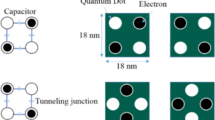Abstract
A simple architecture for data input into a molecular quantum-dot cellular automata (QCA) circuit from an external CMOS circuit is proposed. A “T”-shaped interconnect, utilizing fixed-polarization cells to provide the desired polarization, is controlled via external electrodes connected to a standard CMOS input driver. The applied input signal is used to gate either the propagation of a fixed polarization, P=+1, or that of the complementary fixed polarization, P=−1, into the QCA circuit. The architecture utilizes the field-driven clocking scheme proposed in recent literature to achieve transduction between applied input voltage and a molecular configuration. The system is modelled using the coherence vector formalism with a three-state basis and simulated using the QCADesigner simulation tool.
Similar content being viewed by others
References
Lieberman, M., Chellamma, S., Varughese, B., Wang, Y.L., Lent, C., Bernstein, G.H., Snider, G., Peiris, F.C.: Quantum-dot cellular automata at a molecular scale. Mol. Electron. 960, 225–239 (2002)
Lent, C.S.: Molecular electronics—bypassing the transistor paradigm. Science 288(5471), 1598–1599 (2000)
Lent, C.S.: Quantum cellular automata. Nanotechnology 4, 49–57 (1993)
Lu, Y.H., Lent, C.S.: A metric for characterizing the bistability of molecular quantum-dot cellular automata. Nanotechnology 19(15) (2008)
Lu, Y., Liu, M., Lent, C.: Molecular quantum-dot cellular automata: From molecular structure to circuit dynamics. J. Appl. Phys. 102(3), 034311–7 (2007)
Yuhui, L., Mo, L., Lent, C.: Molecular electronics—from structure to circuit dynamics. In: 6th IEEE Conference on Nanotechnology, vol. 1, pp. 62–65 (2006)
Yuhui, L., Lent, C.S.: Theoretical study of molecular quantum dot cellular automata. In: 10th International Workshop on Computational Electronics, pp. 118–119 (2004)
Hu, W.C., Sarveswaran, K., Lieberman, M., Bernstein, G.H.: High-resolution electron beam lithography and DNA nano-patterning for molecular qca. IEEE Trans. Nanotechnol. 4(3), 312–316 (2005)
Qi, H., : Molecular quantum cellular automata cells. Electric field driven switching of a silicon surface bound array of vertically oriented two-dot molecular quantum cellular automata. J. Am. Chem. Soc. 125(49), 15250–15259 (2003)
Walus, K., Jullien, G.A.: Design tools for an emerging soc technology: Quantum-dot cellular automata. Proc. IEEE 94(6), 1225–1244 (2006)
Hennessy, K., Lent, C.S.: Clocking of molecular quantum-dot cellular automata. J. Vac. Sci. Technol. B 19(5), 1752–1755 (2001)
Blair, E.P., Lent, C.S.: An architecture for molecular computing using quantum-dot cellular automata. In: 3rd IEEE Conference on Nanotechnology, vol. 1, pp. 402–405 (2003)
Lent, C.S., Isaksen, B.: Clocked molecular quantum-dot cellular automata. IEEE Trans. Electron Devices 50(9), 1890–1896 (2003)
Walus, K., Schulhof, G., Jullien, G.A.: Implementation of a simulation engine for clocked molecular qca. In: Canadian Conference on Electrical and Computer Engineering, pp. 2128–2131 (2006)
Timler, J., Lent, C.S.: Maxwell’s demon and quantum-dot cellular automata. J. Appl. Phys. 94(2), 1050–1060 (2003)
Lent, C.S., Liu, M., Lu, Y.H.: Bennett clocking of quantum-dot cellular automata and the limits to binary logic scaling. Nanotechnology 17(16), 4240–4251 (2006)
Mahler, G., Weberrüs, V.A.: Quantum Networks: Dynamics of Open Nanostructures. Springer, Berlin (1998)
Walus, K., Dysart, T.J., Jullien, G.A., Budiman, R.A.: Qcadesigner: A rapid design and simulation tool for quantum-dot cellular automata. Nanotechnol., IEEE Trans. 3(1), 26–31 (2004)
Timler, J., Lent, C.S.: Power gain and dissipation in quantum-dot cellular automata. J. Appl. Phys. 91(2), 823–831 (2002)
Tamura, H., Kibune, M., Yamaguchi, H., Kanda, K., Gotoh, K., Ishida, H., Ogawa, J.: Circuits for CMOS high-speed i/o in sub-100 nm technologies. IEICE Trans. Electron. E 89(3), 300–311 (2006)
Author information
Authors and Affiliations
Corresponding author
Rights and permissions
About this article
Cite this article
Walus, K., Karim, F. & Ivanov, A. Architecture for an external input into a molecular QCA circuit. J Comput Electron 8, 35–42 (2009). https://doi.org/10.1007/s10825-009-0268-0
Received:
Accepted:
Published:
Issue Date:
DOI: https://doi.org/10.1007/s10825-009-0268-0




